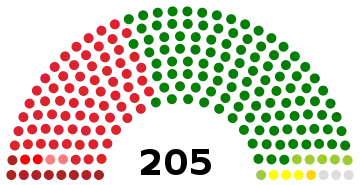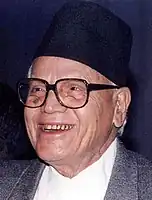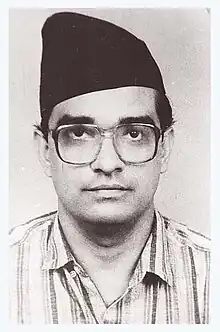 | |||||||||||||||||||
| |||||||||||||||||||
All 205 seats in the House of Representatives 103 seats needed for a majority | |||||||||||||||||||
|---|---|---|---|---|---|---|---|---|---|---|---|---|---|---|---|---|---|---|---|
| Turnout | 65.15% | ||||||||||||||||||
| |||||||||||||||||||
| |||||||||||||||||||
General elections were held in Nepal on 12 May 1991, to elect 205 members to the House of Representatives. The elections were the first multi-party elections since 1959. The 1990 Nepalese revolution successfully made King Birendra to restore a multi-party system after King Mahendra had established the Rastriya Panchayat when he dissolved the parliament in December 1960.[1][2]
Although the Nepali Congress won the most seats, its leader Krishna Prasad Bhattarai lost in his own constituency, Kathmandu 1. Communist leader Madan Kumar Bhandari was elected in both Kathmandu 1 and Kathmandu 5, vacating the latter.
Results
 | ||||
|---|---|---|---|---|
| Party | Votes | % | Seats | |
| Nepali Congress | 2,752,452 | 39.50 | 110 | |
| Communist Party of Nepal (Unified Marxist–Leninist) | 2,040,102 | 29.27 | 69 | |
| Rastriya Prajatantra Party (Chand) | 478,604 | 6.87 | 3 | |
| Rashtriya Prajatantra Party (Thapa) | 392,499 | 5.63 | 1 | |
| United People's Front of Nepal | 351,904 | 5.05 | 9 | |
| Nepal Sadbhavana Party | 298,610 | 4.28 | 6 | |
| Communist Party of Nepal (Democratic) | 177,323 | 2.54 | 2 | |
| Nepal Workers Peasants Party | 91,335 | 1.31 | 2 | |
| Rastriya Janamukti Party | 34,509 | 0.50 | 0 | |
| Communist Party of Nepal (Burma) | 16,698 | 0.24 | 0 | |
| Janata Dal (Samajbadi Prajatantrik) | 5,760 | 0.08 | 0 | |
| Nepal Rastriya Jana Party | 5,732 | 0.08 | 0 | |
| Communist Party of Nepal (Amatya) | 4,846 | 0.07 | 0 | |
| Rastriya Janata Party (H) | 4,406 | 0.06 | 0 | |
| Rastriya Janata Party (Nepal) | 4,280 | 0.06 | 0 | |
| Nepal Conservative Party | 2,562 | 0.04 | 0 | |
| Bahu Jana Janatadal | 2,012 | 0.03 | 0 | |
| Janawadi Morcha Nepal | 1,518 | 0.02 | 0 | |
| Ekata Party | 94 | 0.00 | 0 | |
| Dalit Majdoor Kisan Party | 92 | 0.00 | 0 | |
| Independents | 303,723 | 4.36 | 3 | |
| Total | 6,969,061 | 100.00 | 205 | |
| Valid votes | 6,969,061 | 95.58 | ||
| Invalid/blank votes | 322,023 | 4.42 | ||
| Total votes | 7,291,084 | 100.00 | ||
| Registered voters/turnout | 11,191,777 | 65.15 | ||
| Source: Nohlen et al., IFES | ||||
Aftermath
Following the result of the election, Nepali Congress came to power and Girija Prasad Koirala became Prime Minister.[3] The house met for the first time in May 1991. Daman Nath Dhungana served as the Speaker of the House.[4] The parliament could not complete its full five-year term with Koirala asking King Birendra to dissolve the house in July 1994 after losing a no-confidence motion with some member of his own party voting against him.[5][6]
See also
References
- ↑ "Kingdom of Nepal: Parliamentary Elections, May 12, 1991". www.ifes.org. Retrieved 2020-12-12.
- ↑ "NEPAL'S CABINET IS OUSTED BY KING; Mahendra Seizes Ministers as 'Anti-Nationalists' and Dissolves Parliament NEPAL'S CABINET IS OUSTED BY KING (Published 1960)". The New York Times. 1960-12-16. ISSN 0362-4331. Retrieved 2020-12-12.
- ↑ "Nepal Picks Prime Minister, In Transition to Democracy (Published 1991)". The New York Times. 1991-05-30. ISSN 0362-4331. Retrieved 2020-12-12.
- ↑ "Dhungana makes a comeback to politics after 23 years". kathmandupost.com. Retrieved 2020-12-12.
- ↑ "NEPAL: parliamentary elections Pratinidhi Sabha, 1994". archive.ipu.org. Retrieved 2020-12-12.
- ↑ Moore, Molly (1994-07-12). "NEPAL'S GOVERNMENT COLLAPSES AS KING DISSOLVES LEGISLATURE". Washington Post. ISSN 0190-8286. Retrieved 2020-12-12.

